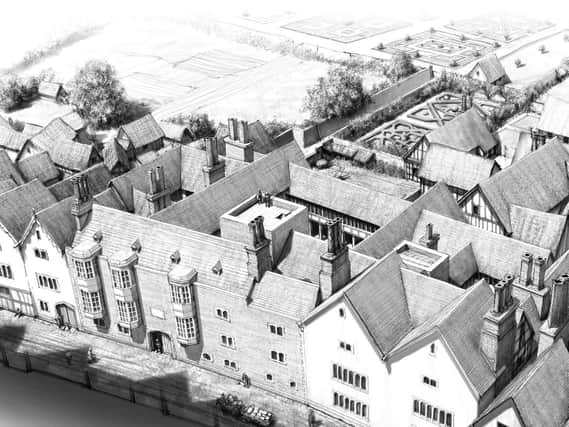Yorkshire uprising delayed construction of Thomas Cromwell's 58-room mansion as workers sent north to fight, historic documents reveal


Documents including letters, leases, surveys and inventories were scrutinised to present a detailed insight into the Tudor homes.
Dr Nick Holder, a historian and research fellow at English Heritage and the University of Exeter, carried out the research which is published in the Journal of the British Archaeological Association.
Advertisement
Hide AdAdvertisement
Hide AdOne of the study's findings was that construction on Cromwell's mansion, which begun in July 1535, was held up when in October the following year, the 80-strong team of workers was sent to Yorkshire to fight the rebels of the Pilgrimage of Grace uprising.
Dr Holder's work includes floor plans for Cromwell’s mansion, featuring 58 rooms, as well as servants garrets, and a large garden, which informed an artists impression created by illustrator Peter Urmston.
It is accompanied by room-by-room analysis of Cromwell’s previous home, a neighbouring 14-room townhouse, for which he is likely to have paid £4 per year in rent.
Inventories from the townhouse reveal its contents during his tenancy, including 28 rings, three of which Cromwell was wearing at the time.
Advertisement
Hide AdAdvertisement
Hide AdDr Holder said the documents relating to the townhouse give an intriguing look into Cromwell’s religious outlook.
“We think of Cromwell as Henry VIII’s henchman, carrying out his policy, including closing down the monasteries, and we know that by about 1530 Cromwell became one of the new Evangelical Protestants,” Dr Holder said.
“But when you look at the inventory of his house in the 1520s, he doesn’t seem such a religious radical, he seems more of a traditional English Catholic.
“He’s got various religious paintings on the wall, he’s got his own holy relic, which is very much associated with traditional Catholics, not with the new Evangelicals, and he’s even got a home altar.
Advertisement
Hide AdAdvertisement
Hide Ad“In the 1520s he seems like much more of a conventional early Tudor Catholic gentleman.”
The townhouse had the coats of arms of Cromwell’s patron Cardinal Wolsey and former patron, Thomas Grey, on display, showing a sense of loyalty beneath his ruthless exterior, Dr Holder added.
Cromwell’s mansion, situated next to the Austin Friars monastery in the City of London, cost at least £1,600 to build, including around £550 on the land.
He had lived in Italy and it is likely the architecture contained fashionable new Italian Renaissance features.
Advertisement
Hide AdAdvertisement
Hide AdDr Holder said Cromwell appeared to have undertaken a “land grab”, confiscating a 22-foot strip of land to enlarge his garden – possibly to feature a bowling alley and tennis court.
The mansion acted as a family home, administrative base and venue for entertainment.
Visitors would have been guided up the large stair towers to one of the first-floor halls decorated with tapestry hangings, the parlour or the ladies’ parlour.
Cromwell’s personal armoury, including several hundred sets of plate amour for infantry, nearly 100 helmets and head-pieces, 759 bows and hundreds of sheaves of arrows, was also kept at the property.
Advertisement
Hide AdAdvertisement
Hide AdDr Holder said: “These two houses were the homes of this great man, they were the places where he lived with his wife and two daughters, where his son grew up.
“It was also the place he went back to at night after being with Henry VIII at court and just got on with the hard graft of running the country.
“No one else has looked at these two houses in quite as much detail comparing all the available evidence.
“This is about as close as you are going to get to walking down these 16th-century corridors.”
Dr Holder’s analysis was made possible due to documents held in the archives of the Draper’s Company, the trade group that bought Cromwell’s mansion after his death in 1540.
Comment Guidelines
National World encourages reader discussion on our stories. User feedback, insights and back-and-forth exchanges add a rich layer of context to reporting. Please review our Community Guidelines before commenting.